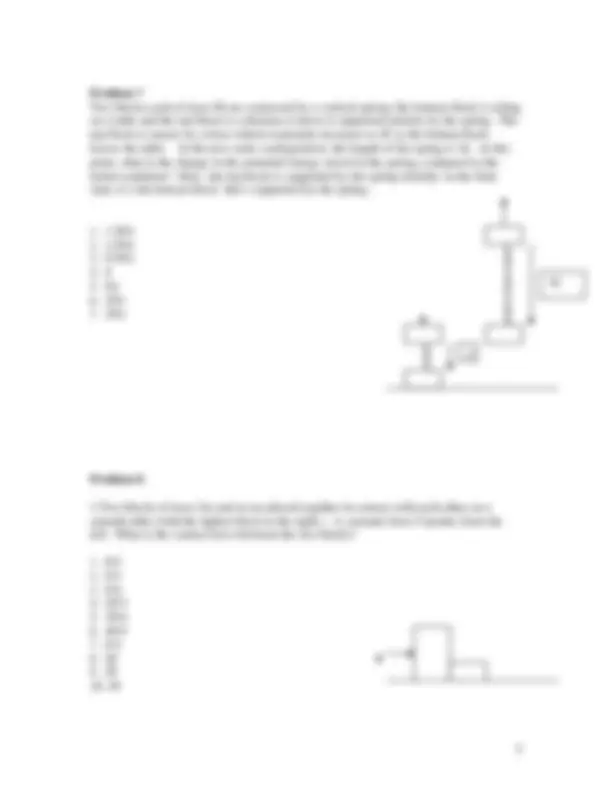









Study with the several resources on Docsity

Earn points by helping other students or get them with a premium plan


Prepare for your exams
Study with the several resources on Docsity

Earn points to download
Earn points by helping other students or get them with a premium plan
Community
Ask the community for help and clear up your study doubts
Discover the best universities in your country according to Docsity users
Free resources
Download our free guides on studying techniques, anxiety management strategies, and thesis advice from Docsity tutors
Practice Exam 2 Physics 172H Purdue University ... When dealing with a system which is an isolated point particle, which forms of energy can change?
Typology: Slides
1 / 13

This page cannot be seen from the preview
Don't miss anything!








You are allowed the use of two one-sheet (2 sides each) crib sheet created by you.
This exam is worth 100 points, of which 20 are for the hand-written last section, and 80 points for the 16 machine graded questions, which are thus worth 5 points each.
All problems except the last set are multiple-choice and there is only one correct answer per problem. Up to 10 alternative answers are provided on the op-scan sheet, but different problems may have fewer than 10 possible answers given.
YOU MUST SIGN THE OP-SCAN SHEET, as well as printing and filling out the relevant bubbles for your name, your 10-digit SID number. Leave Section Number blank. Hand write Test 2 and your TA’s name near your signature.
On the handwritten question page to be handed in, AGAIN print and SIGN your name, also write the name of your TA. (You may keep the rest of the questions.)
When finished with both parts, bring them to the front of the classroom, show your Purdue ID card to the Instructor, and turn in the machine-graded answer sheet and the hand-graded answer sheet at the same time. Your grades will appear in the CHIP gradebook as soon as possible. An answer key will be posted soon on the course home page. You may keep this copy of the exam
Problem 1. A hot microscopic system emits photons of energy 1eV, 2eV, 4eV, 6 eV, and 7 eV, among others. What is the smallest number of bound energy levels possible for this system?
Problem 2. What is the only other possible photon energy for the above system?
Problem 5. A 20 kg ball with velocity <9, 0, 0> m/s collides head-on with a stationary 10 kg ball. What is the x-component of the recoil velocity of the 10 kg ball, if the collision is totally elastic?
Problem 6. A person runs up a flight of stairs with steady vertical component of velocity 1.5 m./s. If the person’s mass is 55 kg, what power is she expending?
Problem 7 Two blocks each of mass M are connected by a vertical spring; the bottom block is sitting on a table and the top block is a distance d above it supported entirely by the spring. The top block is raised, by a force which eventually increases to 2F as the bottom block leaves the table. In the new static configuration, the length of the spring is 3d. At this point, what is the change in the potential energy stored in the spring, compared to the initial condition? Hint: the top block is supported by the spring initially; in the final state, it’s the bottom block that’s supported by the spring..
d
Problem 8.
1.Two blocks of mass 3m and m are placed together in contact with each other on a smooth table (with the lighter block to the right.) A constant force F pushes from the left. What is the contact force between the two blocks?
Problem 11. Which of the following statements about an elliptical orbit are (each and only these) true?
I. At any instant the momentum of the planet is tangent to the planet’s trajectory.
II. At every instant, d p dt / points from the planet to the star.
→
III. The graviatational force on the planet due to the star always acts at a right
. angle to the planet’s momentum. IV. The magnitude of the planet’s momentum is constant. V. The direction of the planet’s momentum is changing at every instant.
Problem 12. A proton is traveling at a speed of 0.9c when it is accelerated in its direction of motion by an electric field which applies a force of 1.2 x 10-11N to the proton over a distance of 10 m. What is the final speed of the proton? Hint: use the Relativsitic relation between rest energy and total energy, first one way, then the opposite way after adding in the energy gained. Take the rest energy of the proton to be 938 MeV.
Problem 13. Masses M and m attract each other with a gravitational force F. Mass m is replaced by a mass 3m and is moved 6 times farther away. Now what is the force?
Problem 14. A kid of mass 50 kg starts up a ramp of height h = 3 m and length L = 10 m and experiences a constant drag force of |Fd| = 250 N. What initial speed does he need to just reach the top of the ramp?
Name (print)_____________________________ TA Name ____________________
Signature_________________________________________________
For this last problem only, you must provide the complete reasoning and solution as requested in the problem.
Correct answers without adequate explanations or with incorrect reasoning will be counted wrong. Cross out anything you don’t want us to read.
Parts 17 - 22. A special yo-yo has a string wrapped around a 0.5 cm diameter shaft. Essentially all of the 1.5 kg mass of the yo-yo is concentrated in a uniform hoop with diameter 20 cm centered on the shaft. The other end of the string is tied to a solid support and the yo-yo is allowed to drop in the Earth’s gravitational field as the string unwinds and the yo-yo spins with increasing angular speed. [USE GEOMETRY AND RATIOS TO RELATE THE SPEED OF FALL OF THE YO-YO TO THE TANGENTIAL SPEED OF THE RIM AROUND THE CM. Make a second drawing of the yo-yo and label one with the lab velocity of the CM, the other with the tangential velocities of the shaft surface and the rim, in the CM reference system. Use energy principles. DO NOT at any point waste time trying to calculate the string tension.]
Part 17. Work out the ratio of vrim/vtransl.
Part 18. After the yo-yo has dropped through 0.8 m, what is its translational kinetic energy? Hint: You will solve 18 and 19 together.
Part 22. What is the (constant) downward acceleration of the CM? (Hint: first use the average velocity to find the time interval.)